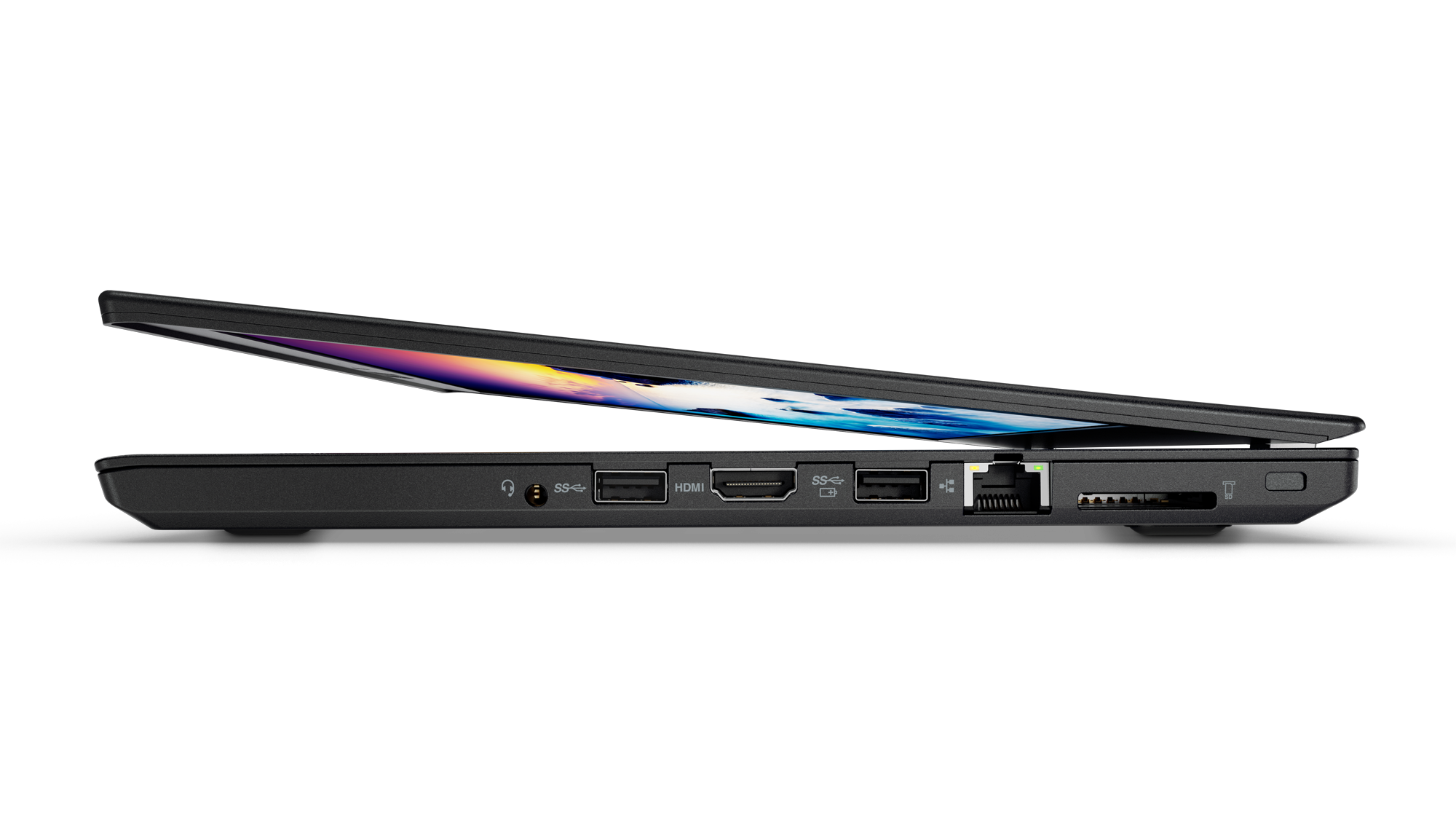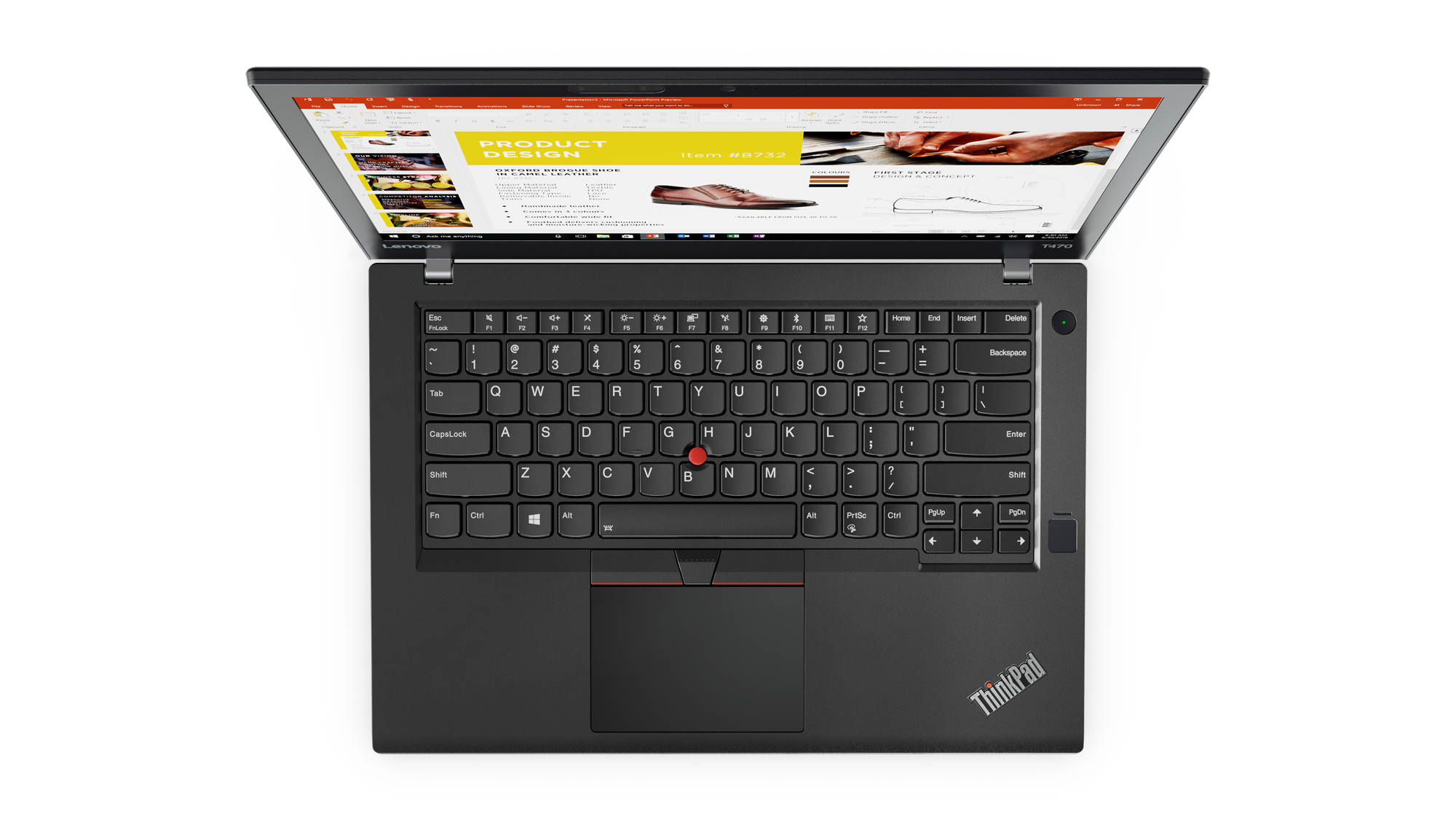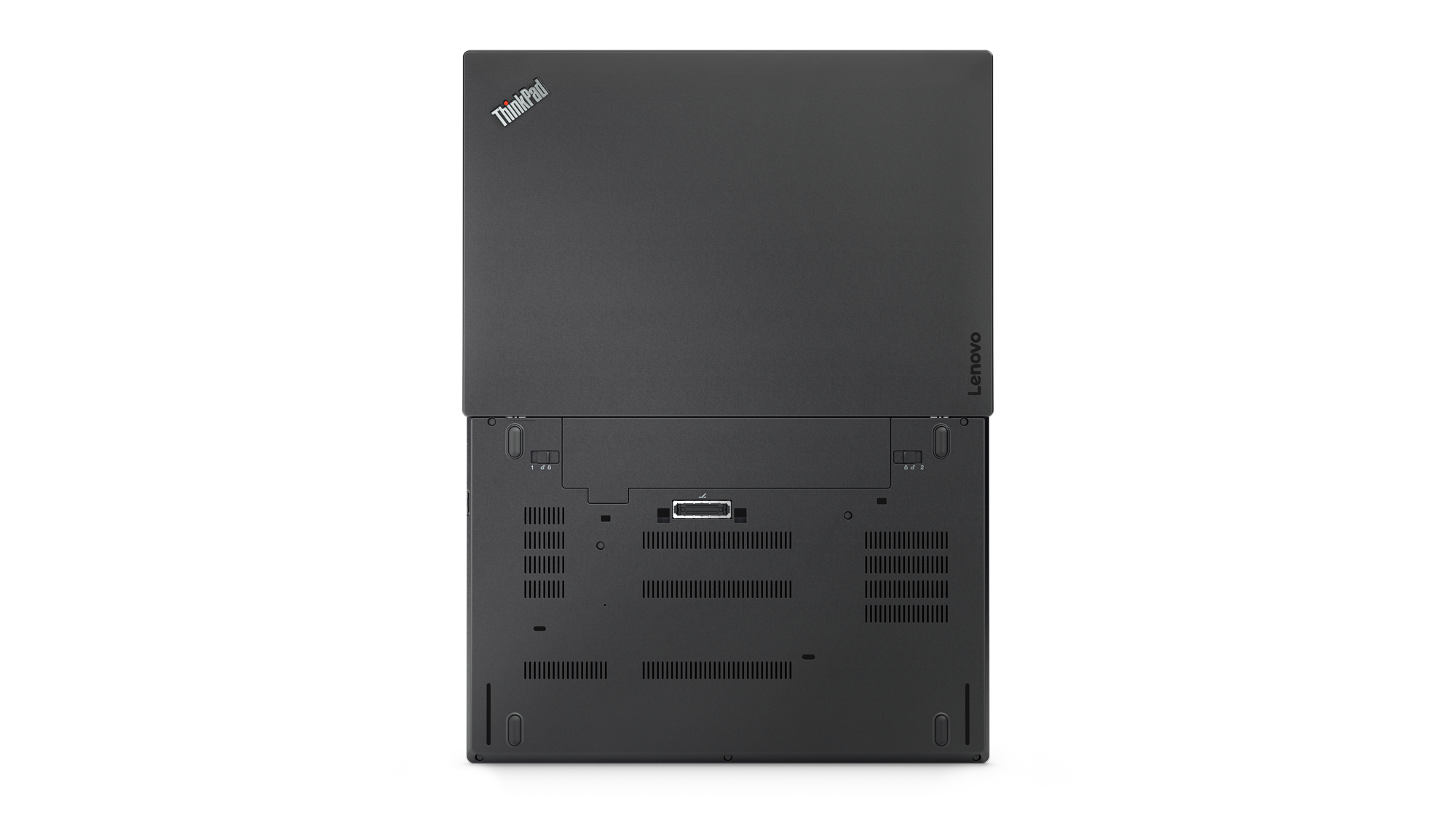In the past two years, Lenovo announced most new ThinkPads at the Consumer Electronics Show (CES) in Las Vegas. It was expected that Lenovo would carry on with this tradition. However, Lenovo decided to announce most new Kaby Lake ThinkPads on December 28, some days prior to CES 2017.
Sadly, Lenovo didn’t provide me the spec sheet of all new Kaby Lake ThinkPads. Furthermore, some Kaby Lake ThinkPads remain nearly unchanged compared to their predecessors. Thus, I’ll focus on the most interesting new ThinkPads. This post will cover the T470 while the posts regarding the other “interesting” Kaby Lake ThinkPads (T570, Yoga 370) will be published in a few days.
Chassis
The T470 is the first T4?? ThinkPad since the T440 with an entirely new chassis. Nevertheless, the overall design is very similar. The minor differences in width and thickness aren’t noteworthy either.
Lenovo claims that the weight of the T470 is starting at 1.58 kg. However, it remains to be seen if the lightest configuration has an internal battery as well as an external battery or if it lacks an internal battery. Thus, we don’t know yet if the weight difference between the T460 and the T470 is noteworthy or not.
| ThinkPad T470 | 336.6 mm x 232.5 mm x 19.95 mm | Starting at 1.58 kg |
| _ThinkPad T460 (for the purpose of comparison)_ | _339 mm x 232.5mm x 21 mm_ | _1.73 kg (3-cell + 3-cell)_ |
Attentive observers might notice that the T470 is truly black again while the color of its predecessors was closer to a dark shade of gray.
Unfortunately, Lenovo didn’t publish the hardware maintenance manual (HMM) of the T470 yet. Thus, we can’t comment on the maintainability of the T470 yet. However, I suspect that the replacement of the keyboard will be easier than before.
Processor
Unsurprisingly, the T470 uses 7th Generation Intel Core i processors (“Kaby Lake”) with a thermal design power of 15 W. Although the microarchitecture remains virtually unchanged, Intel was able to increase both the frequencies and the energy efficiency. As the comparison of mobile processors by Notebookcheck shows, the Core i5-7200U is slightly faster than the old Core i7-6500U due to these improvements.
Graphics
All Kaby Lake processors which are used in the T470 contain the Intel HD Graphics 620. Apart from being 20 to 30% faster than the HD Graphics 520, it decodes H.265/HEVC Main10 and VP9 (the open video coding format developed by Google, mainly used on YouTube) in hardware.
As the T470 uses DDR4-2133 memory while the T460 used slower DDR3L-1600 memory, the performance difference of the integrated GPUs will be even more noticeable when comparing those two models. Furthermore, upgrading the T470 to 20, 24 or 32 GB RAM will be a lot cheaper due to the lower price of 16 GB DDR4 modules.
Similar to the T460, the T470 is also available with the NVIDIA GeForce 940MX. However, Lenovo finally uses the faster GDDR5 version instead of the slower DDR3 version. In my opinion, it is quite sad that NVIDIA doesn’t offer any low-end Pascal GPUs for laptops yet as a (hypothetical) GeForce 1030 would probably be even faster than the 940MX while having nearly the same power consumption.
Display
In general, the screen is one of the most important human–machine interfaces of a laptop. Thus, it is rather incomprehensible that Lenovo didn’t offer the T460 with decent screens. Sadly, Lenovo didn’t learn from this mistake. Instead of offering the T470 with a half-decent screen with at least 300 nits and at least 90% sRGB coverage, they’re still using the same mediocre Full HD IPS screens with 250 nits and less than 70% sRGB coverage. In my opinion, that’s a huge disappointment!
Storage
In contrast to its predecessor, the T470 supports M.2 2280 PCIe NVMe SSDs as well as 2.5” SATA hard drives. Unfortunately, I don’t know yet if it will be possible to use an M.2 2280 SSD and a 2.5” SATA HDD/SSD at the same time.
Ports
Most Skylake ThinkPads lacked modern ports like USB-C or Thunderbolt 3 (which is based on USB-C). Luckily, Lenovo added a Thunderbolt 3 port on some Kaby Lake ThinkPads like the T470, the T470s or the ThinkPad Yoga 370.
Thunderbolt 3 is a versatile port that allows attaching multiple high-resolution external monitors as well as other peripherals to your ThinkPad. Furthermore, it allows to supply your ThinkPad with up to 100 W of power. In my opinion, it is the best solution for single-cable docks with charging. Unsurprisingly, Lenovo also announced a Thunderbolt 3-based docking station, but we’ll cover that in a separate post. However, you can reuse your old docking station if you own one of the predecessors of the T470 (T440, T450, T460) as the T470 is compatible with the “CS13” docking stations (Basic Dock, Pro Dock, Ultra Dock) as well.
In theory, Thunderbolt 3 also allows to use an external graphics card (eGPU). However, it remains to be seen if the T470 supports external GPUs as Lenovo might simply block this feature. Furthermore, Thunderbolt 3 eGPU enclosures are still very expensive: the Akitio Node, one of the cheapest enclosures, starts at $299.
While some other laptops with Thunderbolt 3 like the latest MacBook Pro models don’t have any “legacy” ports like HDMI or USB Type A, the ThinkPad T470 has plenty of them: similar to its predecessor, it has three USB 3.0 Type A ports, one HDMI port and a 3.5 mm audio jack. There even is an Ethernet port and an SD card reader! Furthermore, the T470 is available with a smart card reader.
As the picture below shows, the distance between the ports on the right side of the T470 seem to be rather small. I may be wrong, but it looks like you might block one of the neighboring ports when using a wide USB stick or a wide HDMI cable.
 Ports on the right side of the T470
Ports on the right side of the T470
Wireless connectivity
| Intel® 8265 2 x 2 11 ac & Bluetooth® 4.1 | Qualcomm® Snapdragon™ X7 LTE-A(Sierra Wireless EM7455) |
| Realtek RTL8822BE 2 x 2 11 ac + Bluetooth® 4.1 | Intel® XMM™ 7160 (Fibocom L831-EAU) |
As the name implies, there are no noteworthy differences between the Intel Dual Band Wireless-AC 8265 and the older Intel Dual Band Wireless-AC 8260. The spec sheet doesn’t explicitly mention a WiGig & WLAN combo module, but I guess that the T470 will be available with the Intel Tri-Band Wireless-AC 18265 (the successor of the Intel Tri-Band Wireless-AC 18260 which was available in the T460). The Sierra Wireless EM7455 LTE-A module was already available in the T460. However, the T470 isn’t available with the HUAWEI ME906S LTE module anymore. Instead, you can get it with a Fibocom L831-EAU LTE module. In contrast to the Sierra LTE-A module, the Fibocom LTE module supports 2G networks as a fallback.
All in all, it seems that there are no noteworthy improvements in this area. Sadly, Lenovo still doesn’t offer 3x3 WLAN ac modules.
Input devices
In general, the keyboard of the T460 was one of the best laptop keyboards. Nevertheless, there was still a lot of room for improvements. As the table below shows, the special functions of some function keys barely made sense.
By default, you have to press the Fn key and the corresponding function key if you want to input F1 - F12. However, it is hereafter assumed that the user has enabled the “Fn Lock” function.
| Fn + F9 | Opens the Settings window | Windows key + I |
| Fn + F10 | Opens the Cortana search box | Windows key + S |
| Fn + F11 | Views all the programs that you have opened. | Alt + Tab |
Apparently, Lenovo came to the same conclusion as the keys F10 to F12 have different alternative functions on most Kaby Lake ThinkPads. The key combination Fn + F10 now toggles Bluetooth while the key combination Fn + F11 opens the keyboard settings page in the Lenovo Settings app. Last but not least, the function of the key combination Fn + F12 can be configured by the user. While the function of the key combination Fn + F11 isn’t that useful, the other two alternative functions are quite helpful, at least in my opinion.
Furthermore, the keyboard of the T460 entirely lacked media control keys (Play/Pause, Previous, Next). Sadly, Lenovo didn’t address this issue.
Yet again, some ThinkPad enthusiasts criticized the 6-row keyboard layout of the T460 which was introduced with the T430. In contrast to the old 7-row keyboard layout which is much closer to the layout of a conventional desktop keyboard, some keys like the Break key or the Scroll Lock key were replaced by key combinations while other keys like the page up and the page down key are in odd positions. Furthermore, the context menu key was removed entirely and replaced by the Print Screen key. Unsurprisingly, Lenovo didn’t address this
criticism either as the T470 still has a 6-row keyboard layout.
 Input devices of the T470
As the picture shows, Lenovo changed the labeling of the function keys. Furthermore, they introduced a new key combination (Fn + PrtSc) which opens the Snipping Tool. However, these changes aren’t exactly setting the world on fire.
Input devices of the T470
As the picture shows, Lenovo changed the labeling of the function keys. Furthermore, they introduced a new key combination (Fn + PrtSc) which opens the Snipping Tool. However, these changes aren’t exactly setting the world on fire.
The most interesting change regarding the input devices of the new Kaby Lake ThinkPads can’t be seen on pictures: all Kaby Lake ThinkPads have a so-called “Precision Touchpad”. On the one hand, it fulfills certain requirements set by Microsoft regarding size and responsiveness. On the other hand, gestures aren’t handled by a combination of the touchpad firmware and proprietary drivers anymore. Instead, the raw touch input is exposed to Windows. This allows Microsoft to add new gestures or refine the algorithms with new Windows updates.
Security
Unsurprisingly, the T470 is available with a touch fingerprint reader instead of the swipe fingerprint reader. While using your finger to sign in to your device instead of having to type in a long password sure is quite comfortable, you should keep in mind that the security of fingerprint readers used in laptops is often questionable. The same is true for the new (optional) infrared camera which can be used for Windows Hello face authentication.
In contrast to its predecessor which had a discrete TPM 1.2 and a firmware-based TPM 2.0, the T470 has a discrete TPM 2.0.
Battery life
According to the spec sheet, the T470 will have “up to 18 hours” of battery life. However, Lenovo doesn’t mention the size of the batteries.
As the image of the bottom side shows, the T470 will have “Power Bridge”: there is the “emergency reset hole” which doesn’t make sense without an internal battery and there is an external battery. As the external battery seems to have the same size as the current 3-cell external battery (called “68”), I guess that it will have the same 23.5 Watt hours as before. It remains to be seen if the internal battery has 23.5 Watt hours as well. Bottom side of the T470
Bottom side of the T470
Software
While older Lenovo devices often shipped with lots of useless bloatware, the T470 will be available with the so-called “Signature Edition” of Windows 10 which lacks pre-installed bloatware.
You should also keep in mind that Windows 10 is the only supported Windows version on Kaby Lake devices.
Conclusion
All in all, the ThinkPad T470 seems to be a solid device and it’s a great improvement over the T460. However, it is utterly disappointing that Lenovo doesn’t offer the T470 with a decent screen.
What do you think?